Xingyi Zhang
School of Mechanical Engineering, Shanghai Jiao Tong University
Chi-Square Wavelet Graph Neural Networks for Heterogeneous Graph Anomaly Detection
May 25, 2025Abstract:Graph Anomaly Detection (GAD) in heterogeneous networks presents unique challenges due to node and edge heterogeneity. Existing Graph Neural Network (GNN) methods primarily focus on homogeneous GAD and thus fail to address three key issues: (C1) Capturing abnormal signal and rich semantics across diverse meta-paths; (C2) Retaining high-frequency content in HIN dimension alignment; and (C3) Learning effectively from difficult anomaly samples with class imbalance. To overcome these, we propose ChiGAD, a spectral GNN framework based on a novel Chi-Square filter, inspired by the wavelet effectiveness in diverse domains. Specifically, ChiGAD consists of: (1) Multi-Graph Chi-Square Filter, which captures anomalous information via applying dedicated Chi-Square filters to each meta-path graph; (2) Interactive Meta-Graph Convolution, which aligns features while preserving high-frequency information and incorporates heterogeneous messages by a unified Chi-Square Filter; and (3) Contribution-Informed Cross-Entropy Loss, which prioritizes difficult anomalies to address class imbalance. Extensive experiments on public and industrial datasets show that ChiGAD outperforms state-of-the-art models on multiple metrics. Additionally, its homogeneous variant, ChiGNN, excels on seven GAD datasets, validating the effectiveness of Chi-Square filters. Our code is available at https://github.com/HsipingLi/ChiGAD.
SpaceGNN: Multi-Space Graph Neural Network for Node Anomaly Detection with Extremely Limited Labels
Feb 05, 2025



Abstract:Node Anomaly Detection (NAD) has gained significant attention in the deep learning community due to its diverse applications in real-world scenarios. Existing NAD methods primarily embed graphs within a single Euclidean space, while overlooking the potential of non-Euclidean spaces. Besides, to address the prevalent issue of limited supervision in real NAD tasks, previous methods tend to leverage synthetic data to collect auxiliary information, which is not an effective solution as shown in our experiments. To overcome these challenges, we introduce a novel SpaceGNN model designed for NAD tasks with extremely limited labels. Specifically, we provide deeper insights into a task-relevant framework by empirically analyzing the benefits of different spaces for node representations, based on which, we design a Learnable Space Projection function that effectively encodes nodes into suitable spaces. Besides, we introduce the concept of weighted homogeneity, which we empirically and theoretically validate as an effective coefficient during information propagation. This concept inspires the design of the Distance Aware Propagation module. Furthermore, we propose the Multiple Space Ensemble module, which extracts comprehensive information for NAD under conditions of extremely limited supervision. Our findings indicate that this module is more beneficial than data augmentation techniques for NAD. Extensive experiments conducted on 9 real datasets confirm the superiority of SpaceGNN, which outperforms the best rival by an average of 8.55% in AUC and 4.31% in F1 scores. Our code is available at https://github.com/xydong127/SpaceGNN.
Learning states enhanced knowledge tracing: Simulating the diversity in real-world learning process
Dec 27, 2024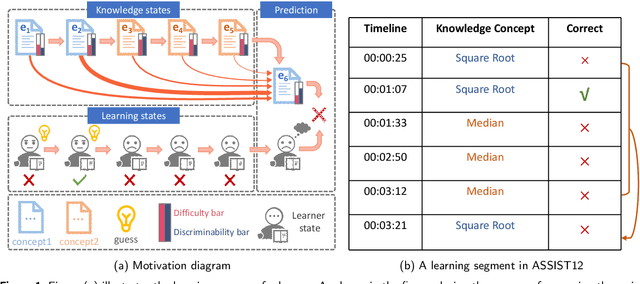
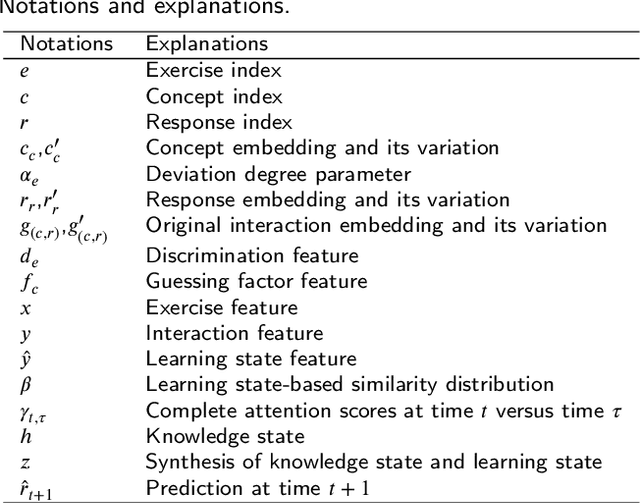
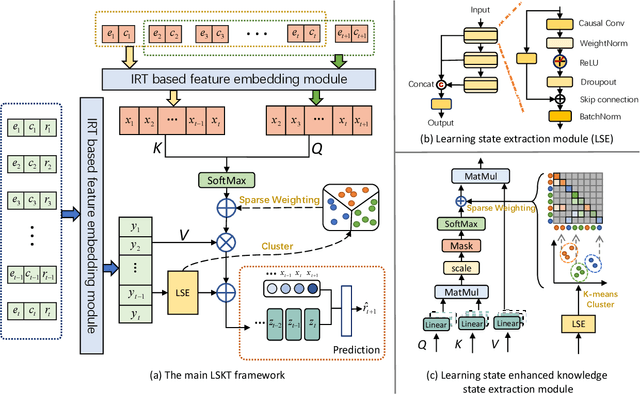

Abstract:The Knowledge Tracing (KT) task focuses on predicting a learner's future performance based on the historical interactions. The knowledge state plays a key role in learning process. However, considering that the knowledge state is influenced by various learning factors in the interaction process, such as the exercises similarities, responses reliability and the learner's learning state. Previous models still face two major limitations. First, due to the exercises differences caused by various complex reasons and the unreliability of responses caused by guessing behavior, it is hard to locate the historical interaction which is most relevant to the current answered exercise. Second, the learning state is also a key factor to influence the knowledge state, which is always ignored by previous methods. To address these issues, we propose a new method named Learning State Enhanced Knowledge Tracing (LSKT). Firstly, to simulate the potential differences in interactions, inspired by Item Response Theory~(IRT) paradigm, we designed three different embedding methods ranging from coarse-grained to fine-grained views and conduct comparative analysis on them. Secondly, we design a learning state extraction module to capture the changing learning state during the learning process of the learner. In turn, with the help of the extracted learning state, a more detailed knowledge state could be captured. Experimental results on four real-world datasets show that our LSKT method outperforms the current state-of-the-art methods.
Balancing property optimization and constraint satisfaction for constrained multi-property molecular optimization
Nov 19, 2024



Abstract:Molecular optimization, which aims to discover improved molecules from a vast chemical search space, is a critical step in chemical development. Various artificial intelligence technologies have demonstrated high effectiveness and efficiency on molecular optimization tasks. However, few of these technologies focus on balancing property optimization with constraint satisfaction, making it difficult to obtain high-quality molecules that not only possess desirable properties but also meet various constraints. To address this issue, we propose a constrained multi-property molecular optimization framework (CMOMO), which is a flexible and efficient method to simultaneously optimize multiple molecular properties while satisfying several drug-like constraints. CMOMO improves multiple properties of molecules with constraints based on dynamic cooperative optimization, which dynamically handles the constraints across various scenarios. Besides, CMOMO evaluates multiple properties within discrete chemical spaces cooperatively with the evolution of molecules within an implicit molecular space to guide the evolutionary search. Experimental results show the superior performance of the proposed CMOMO over five state-of-the-art molecular optimization methods on two benchmark tasks of simultaneously optimizing multiple non-biological activity properties while satisfying two structural constraints. Furthermore, the practical applicability of CMOMO is verified on two practical tasks, where it identified a collection of candidate ligands of $\beta$2-adrenoceptor GPCR and candidate inhibitors of glycogen synthase kinase-3$\beta$ with high properties and under drug-like constraints.
Diffusion-Inspired Cold Start with Sufficient Prior in Computerized Adaptive Testing
Nov 19, 2024Abstract:Computerized Adaptive Testing (CAT) aims to select the most appropriate questions based on the examinee's ability and is widely used in online education. However, existing CAT systems often lack initial understanding of the examinee's ability, requiring random probing questions. This can lead to poorly matched questions, extending the test duration and negatively impacting the examinee's mindset, a phenomenon referred to as the Cold Start with Insufficient Prior (CSIP) task. This issue occurs because CAT systems do not effectively utilize the abundant prior information about the examinee available from other courses on online platforms. These response records, due to the commonality of cognitive states across different knowledge domains, can provide valuable prior information for the target domain. However, no prior work has explored solutions for the CSIP task. In response to this gap, we propose Diffusion Cognitive States TransfeR Framework (DCSR), a novel domain transfer framework based on Diffusion Models (DMs) to address the CSIP task. Specifically, we construct a cognitive state transition bridge between domains, guided by the common cognitive states of examinees, encouraging the model to reconstruct the initial ability state in the target domain. To enrich the expressive power of the generated data, we analyze the causal relationships in the generation process from a causal perspective. Redundant and extraneous cognitive states can lead to limited transfer and negative transfer effects. Our DCSR can seamlessly apply the generated initial ability states in the target domain to existing question selection algorithms, thus improving the cold start performance of the CAT system. Extensive experiments conducted on five real-world datasets demonstrate that DCSR significantly outperforms existing baseline methods in addressing the CSIP task.
DisenGCD: A Meta Multigraph-assisted Disentangled Graph Learning Framework for Cognitive Diagnosis
Oct 23, 2024



Abstract:Existing graph learning-based cognitive diagnosis (CD) methods have made relatively good results, but their student, exercise, and concept representations are learned and exchanged in an implicit unified graph, which makes the interaction-agnostic exercise and concept representations be learned poorly, failing to provide high robustness against noise in students' interactions. Besides, lower-order exercise latent representations obtained in shallow layers are not well explored when learning the student representation. To tackle the issues, this paper suggests a meta multigraph-assisted disentangled graph learning framework for CD (DisenGCD), which learns three types of representations on three disentangled graphs: student-exercise-concept interaction, exercise-concept relation, and concept dependency graphs, respectively. Specifically, the latter two graphs are first disentangled from the interaction graph. Then, the student representation is learned from the interaction graph by a devised meta multigraph learning module; multiple learnable propagation paths in this module enable current student latent representation to access lower-order exercise latent representations, which can lead to more effective nad robust student representations learned; the exercise and concept representations are learned on the relation and dependency graphs by graph attention modules. Finally, a novel diagnostic function is devised to handle three disentangled representations for prediction. Experiments show better performance and robustness of DisenGCD than state-of-the-art CD methods and demonstrate the effectiveness of the disentangled learning framework and meta multigraph module. The source code is available at \textcolor{red}{\url{https://github.com/BIMK/Intelligent-Education/tree/main/DisenGCD}}.
DISCO: A Hierarchical Disentangled Cognitive Diagnosis Framework for Interpretable Job Recommendation
Oct 10, 2024



Abstract:The rapid development of online recruitment platforms has created unprecedented opportunities for job seekers while concurrently posing the significant challenge of quickly and accurately pinpointing positions that align with their skills and preferences. Job recommendation systems have significantly alleviated the extensive search burden for job seekers by optimizing user engagement metrics, such as clicks and applications, thus achieving notable success. In recent years, a substantial amount of research has been devoted to developing effective job recommendation models, primarily focusing on text-matching based and behavior modeling based methods. While these approaches have realized impressive outcomes, it is imperative to note that research on the explainability of recruitment recommendations remains profoundly unexplored. To this end, in this paper, we propose DISCO, a hierarchical Disentanglement based Cognitive diagnosis framework, aimed at flexibly accommodating the underlying representation learning model for effective and interpretable job recommendations. Specifically, we first design a hierarchical representation disentangling module to explicitly mine the hierarchical skill-related factors implied in hidden representations of job seekers and jobs. Subsequently, we propose level-aware association modeling to enhance information communication and robust representation learning both inter- and intra-level, which consists of the interlevel knowledge influence module and the level-wise contrastive learning. Finally, we devise an interaction diagnosis module incorporating a neural diagnosis function for effectively modeling the multi-level recruitment interaction process between job seekers and jobs, which introduces the cognitive measurement theory.
Reconstruction of Particle Flow Energy Distribution Using Deep Learning Algorithms
Oct 08, 2024Abstract:In high-energy particle physics, extracting information from complex detector signals is crucial for energy reconstruction. Recent advancements involve using deep learning to process calorimeter images from various sub-detectors in experiments like the Large Hadron Collider (LHC) for energy map reconstruction. This paper compares classical algorithms\-MLP, CNN, U-Net, and RNN\-with variants that include self-attention and 3D convolution modules to evaluate their effectiveness in reconstructing the initial energy distribution. Additionally, a test dataset of jet events is utilized to analyze and compare models' performance in handling anomalous high-energy events. The analysis highlights the effectiveness of deep learning techniques for energy image reconstruction and explores their potential in this area.
Dual-stream Feature Augmentation for Domain Generalization
Sep 07, 2024
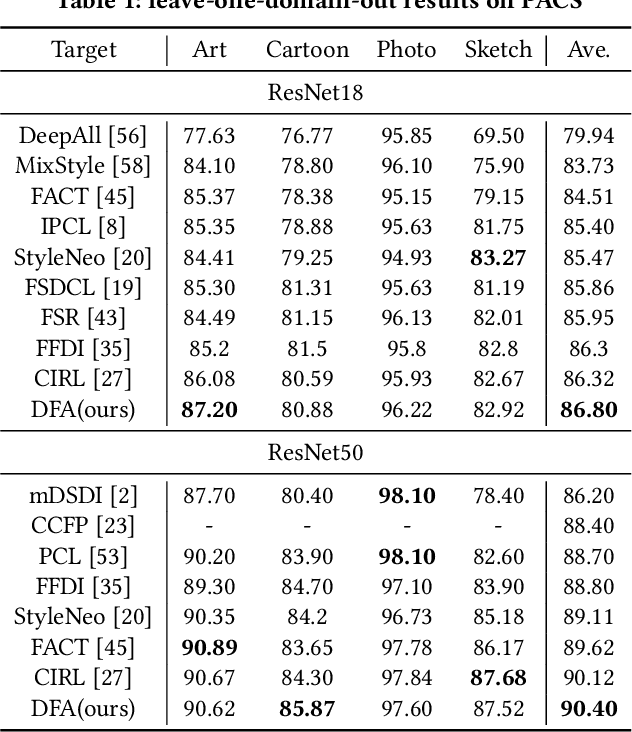

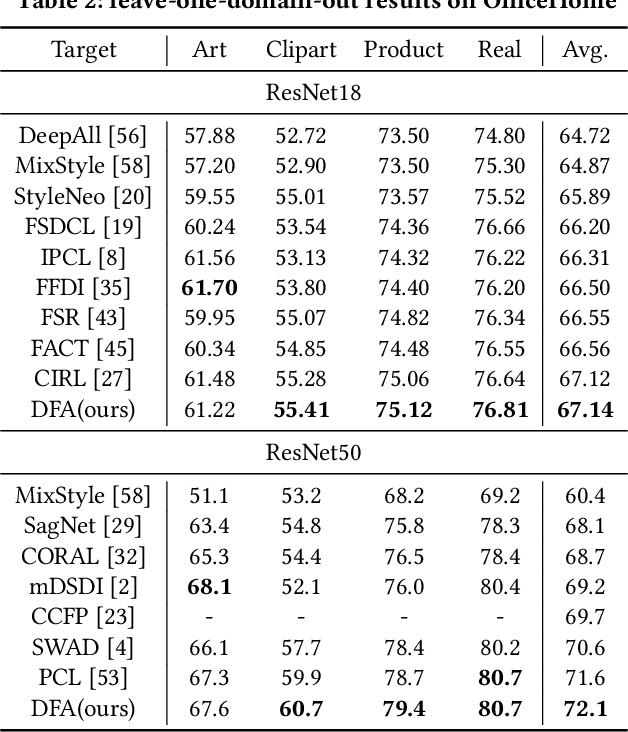
Abstract:Domain generalization (DG) task aims to learn a robust model from source domains that could handle the out-of-distribution (OOD) issue. In order to improve the generalization ability of the model in unseen domains, increasing the diversity of training samples is an effective solution. However, existing augmentation approaches always have some limitations. On the one hand, the augmentation manner in most DG methods is not enough as the model may not see the perturbed features in approximate the worst case due to the randomness, thus the transferability in features could not be fully explored. On the other hand, the causality in discriminative features is not involved in these methods, which harms the generalization ability of model due to the spurious correlations. To address these issues, we propose a Dual-stream Feature Augmentation~(DFA) method by constructing some hard features from two perspectives. Firstly, to improve the transferability, we construct some targeted features with domain related augmentation manner. Through the guidance of uncertainty, some hard cross-domain fictitious features are generated to simulate domain shift. Secondly, to take the causality into consideration, the spurious correlated non-causal information is disentangled by an adversarial mask, then the more discriminative features can be extracted through these hard causal related information. Different from previous fixed synthesizing strategy, the two augmentations are integrated into a unified learnable feature disentangle model. Based on these hard features, contrastive learning is employed to keep the semantic consistency and improve the robustness of the model. Extensive experiments on several datasets demonstrated that our approach could achieve state-of-the-art performance for domain generalization. Our code is available at: https://github.com/alusi123/DFA.
RIGL: A Unified Reciprocal Approach for Tracing the Independent and Group Learning Processes
Jun 18, 2024Abstract:In the realm of education, both independent learning and group learning are esteemed as the most classic paradigms. The former allows learners to self-direct their studies, while the latter is typically characterized by teacher-directed scenarios. Recent studies in the field of intelligent education have leveraged deep temporal models to trace the learning process, capturing the dynamics of students' knowledge states, and have achieved remarkable performance. However, existing approaches have primarily focused on modeling the independent learning process, with the group learning paradigm receiving less attention. Moreover, the reciprocal effect between the two learning processes, especially their combined potential to foster holistic student development, remains inadequately explored. To this end, in this paper, we propose RIGL, a unified Reciprocal model to trace knowledge states at both the individual and group levels, drawing from the Independent and Group Learning processes. Specifically, we first introduce a time frame-aware reciprocal embedding module to concurrently model both student and group response interactions across various time frames. Subsequently, we employ reciprocal enhanced learning modeling to fully exploit the comprehensive and complementary information between the two behaviors. Furthermore, we design a relation-guided temporal attentive network, comprised of dynamic graph modeling coupled with a temporal self-attention mechanism. It is used to delve into the dynamic influence of individual and group interactions throughout the learning processes. Conclusively, we introduce a bias-aware contrastive learning module to bolster the stability of the model's training. Extensive experiments on four real-world educational datasets clearly demonstrate the effectiveness of the proposed RIGL model.
 Add to Chrome
Add to Chrome Add to Firefox
Add to Firefox Add to Edge
Add to Edge